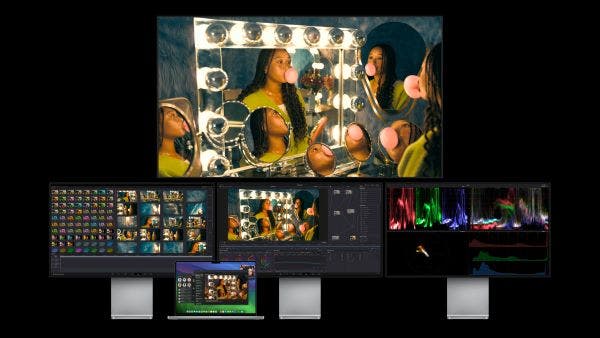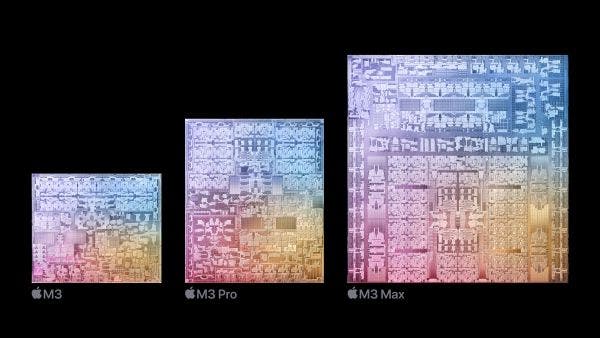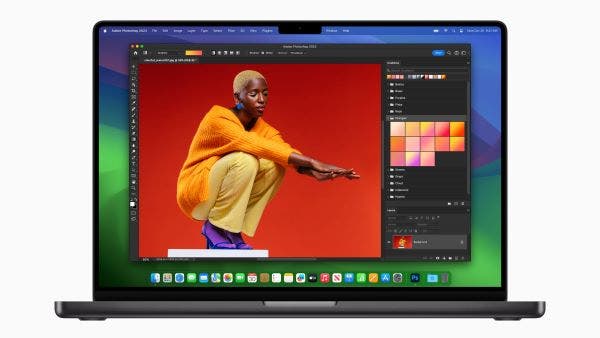Apple’s MacBook Pro, iMac Get Big M3 Chip Upgrade: 5 Things To Know
The M3 chips inside the new MacBook Pros and iMac provide what Apple calls its biggest generational leap yet in GPU performance, a faster CPU for a broad variety of applications and a faster Neural Engine for AI tasks.

Apple is promising to deliver major leaps in performance and fresh capabilities with the new family of M3 chips inside its forthcoming MacBook Pro and iMac computers.
The Cupertino, Calif.-based tech giant revealed new 14- and 16-inch MacBook Pros powered by the M3, M3 Pro and M3 Max alongside a new 24-inch iMac running on an M3 during a live-streamed event from its headquarters on Monday. Availability for the new devices begins on Nov. 7.
[Related: Apple: Mac’s Transition From Intel Has Lured Influx Of New Customers]
“They are the most advanced chips ever created for a personal computer, taking the best pro laptops in the world and making them even better. And with M3 coming to iMac, the world’s best all-in-one gets even more powerful and more capable,” said Apple CEO Tim Cook.
What follows are five big things to know about the new 14- and 16-inch MacBook Pros, the new 24-inch iMac as well as the new M3 family of chips that power them.

M3 Chips Pack Up To 16-Core CPU, 40-Core GPU
Using a 3-nanometer manufacturing process, the M3’s transistors are so small that two million of them can fit in the cross-section of a human hair, according to Johny Srouji, who leads Apple’s silicon design as senior vice president of hardware technologies.
This reduction in transistor size from Apple’s previous generation of M-series chips allowed the company to “advance every component” and pack as many as 92 billion transistors on the M3 chips to enable increased performance and new features.
As a result, the M3 chips provide what Apple called its biggest generational leap yet in graphics performance, a faster CPU for a broad variety of applications, a faster Neural Engine for machine learning tasks, and a new media engine with support for AV1 decode.
The M3 packs 25 billion transistors and comes with an eight-core CPU—split between four performance cores and four efficiency cores—a 10-core GPU and up to 24GB of unified memory. Compared to the M1, the M3’s CPU is as much as 35 percent faster than the M1’s while the GPU is up to 65 faster, Apple said.
The M3 Pro, on the other hand, contains 37 billion transistors and features a 12-core CPU—split between six performance cores and six efficiency cores—an 18-core GPU and up to 36GB of unified memory. The CPU provides a maximum performance boost of 30 percent while the GPU is up to 40 percent faster compared to those in the M1 Pro, according to Apple.
Finally, the M3 Max is Apple’s biggest processor yet, consisting of 92 billion transistors and sporting a 16-core CPU—split between 12 performance cores and four efficiency cores—a 40-core GPU and up to 128GB of unified memory. The CPU is up to 80 percent faster while the GPU is as much as 50 percent faster than those of the M1 Max, the company said.

New Features Boost Graphics And AI Capabilities
Apple said the new M3 chips come with new features that will boost graphics and AI capabilities for the forthcoming MacBook Pros and iMac.
For instance, the new GPU architecture comes with a “industry-first” feature called dynamic caching, which Apple said isn’t available in GPUs from other companies such as Nvidia.
By allocating the exact amount of memory needed for each task, dynamic caching “dramatically increases the average utilization of the GPU, which significantly increases performance for the most demanding pro apps and games,” according to Apple.
The M3 GPU also introduces, for the first time in the M-series, hardware-accelerated ray tracing, a feature that debuted in Nvidia GPUs in 2018, enabling the real-time simulation of lights and reflections in computer games and other 3-D applications.
Another new GPU feature for the M3 family of chips is hardware-accelerated mesh shading, which enables “more visually complex scenes in games and graphics-intensive apps” by “delivering greater capability and efficiency to geometry processing,” Apple said.
On the AI side, Apple said the M3 chips enable new capabilities in a few ways.
With the maximum 128GB of unified memory in the M3 Max, the chip can run large transformer models with billions of parameters for AI developers, according to Apple.
For a broader variety of AI and machine learning workflows, the improved Neural Engine in the M3, M3 Pro and M3 Max can run 60 percent faster than that of their M1 counterparts while “keeping data on device to preserve privacy,” the company said.
These workflows include AI image processing tools, like noise reduction and super resolution in Topaz’s image editing software, as well as scene edit detection in Adobe’s Premiere Pro video editing software and smart conform in Apple’s Final Cut Pro.

Prices And Specs For 14- And 16-Inch MacBook Pros
The new 14-inch MacBook Pro supports configurations with the M3, M3 Pro and M3 Max while the new 16-inch model only supports the M3 Pro and M3 Max.
The 14-inch MacBook Pro with an M3 starts at $1,599. The base configuration comes with an eight-core CPU, a 10-core GPU, 8GB of unified memory and a 512GB SSD, and there are options for up to 24GB of unified memory and 2TB of SSD storage.
The model also comes with two Thunderbolt/USB 4 ports, an HDMI port, an SDXC card slot, a headphone jack and a MagSafe 3 port.
The 14-inch MacBook Pro with an M3 Pro starts at $1,999. The base configuration comes with an 11-core CPU, 14-core GPU, 18GB of unified memory and a 512GB SSD. It can be upgraded up to a 12-core CPU, 18-core GPU, 36GB of unified memory and a 4TB SSD.
The 14-inch MacBook Pro with an M3 Max starts at $3,199. The base configuration comes with a 14-core CPU, a 30-core GPU, 36GB of unified memory and a 1TB SSD. It can be upgraded up to a 16-core CPU, 40-core GPU, 128GB of unified memory and an 8TB SSD.
The M3 Pro and M3 Max versions of the 14-inch MacBook Pro come with three Thunderbolt 4 ports, an HDMI port, an SDXC card slot, a headphone jack and a MagSafe 3 port.
The 16-inch MacBook Pro with an M3 Pro starts at $2,499. The base configuration comes with a 12-core CPU, an 18-core GPU, 18GB of unified memory and a 512GB SSD. It can be upgraded to 36GB of unified memory and up to a 4TB SSD.
The 16-inch MacBook Pro with an M3 Max starts at $3,499. The base configuration comes with a 14-core CPU, a 30-core GPU, 36GB of unified memory and a 1TB SSD. It can be upgraded up to a 16-core CPU, a 40-core GPU, 128GB of unified memory and an 8TB SSD.
All versions of the new 16-inch MacBook Pro come with three Thunderbolt 4 ports, an HDMI port, an SDXC card slot, a headphone jack and a MagSafe 3 port.
The 14- and 16-inch MacBook Pro models with the M3 Pro or M3 Max are available in the all-new space black aluminum finish. All models come with a Liquid Retina XDR display with 20 percent brighter SDR content than the previous generation, a 1080p camera and an immersive six-speaker sound system.

14- and 16-Inch MacBook Pros A ‘Big Upgrade’ Over Intel Version
While Apple is hoping that early adopters of M1-powered MacBook Pros upgrade to the latest M3-based models, the company is also framing the new line of professional laptops as a “big upgrade” over the fastest and latest Mac notebooks powered by Intel CPUs.
For instance, the tech giant said the M3 Max version of the 16-inch MacBook Pro is up to 11 times faster than a 16-inch MacBook Pro from 2019 with an eight-core Intel Core i9 CPU, an AMD Radeon Pro 5600 GPU with 8GB of HBM2, 64GB of RAM and an 8TB SSD.
Apple also emphasized that the new 14-inch, M3-powered MacBook Pro provides up to 11 additional battery hours over the 2019 Intel-based model.

Prices And Specs For 24-Inch iMac
The 24-inch iMac powered by the M3 starts at $1,299. The base configuration comes with an 8-core CPU, an 8-core GPU, 8GB of unified memory, a 256GB SSD, the Magic Mouse and the Magic Keyboard with Touch ID. It can be upgraded to as much as 24GB of unified memory and a 2TB SSD. It can also come with both a Magic Mouse and a Magic Trackpad as well as a Magic Keyboard with a numeric keypad.
Apple said the new iMac is up to two times faster than the previous generation with the M1, and it also claimed that the computer is as much as 2.5 times faster than its previous 27-inch version from 2020 with an Intel Core i5 CPU and AMD Radeon Pro 5300 GPU.
The 24-inch iMac comes with what Apple called an “expansive 4.5K Retina display with 11.3 million pixels and over a billion colors.”